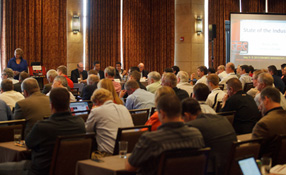 |
| Layering as applied to computers is a made up term having no relationship to any particular standards |
When it comes to setting the criteria for network switching, we often hear “I only want a layer 3 switch.” We naturally assume that since the number 3 is bigger than the number 2, a layer 3 switch must be better than a layer 2 switch. It may surprise you, but when it comes to video security applications, this may not be the case. In fact, just the opposite may be true.
Layer Is A Marketing Term And Not A Technical Term
Defining a network switch is a difficult task, and adding the concept of layers just makes it more difficult. Layer is a term applied to the organisation of protocols reflecting functions that must be performed in a certain order for programs contained within physical devices to communicate with each other. If all that is too complex, just realise layering as applied to computers is a made up term having no relationship to any particular standards. It is a Marketing Term and not a Technical Term.
What Is A Layer 2 Process?
In short, Layer 2 operates by learning the Media Access Control or MAC address of the device connected to each port and, when commanded, forwarding the requested information from that device to the requested port. For example: We have two security cameras, one connected to port one and the other connected to port two of the switch. At port three we have a VMS server. By knowing the MAC address of each of these devices, when the VMS server requests information from a camera, the switch knows that camera one is connected to port one and forwards that information to port three. The same process holds true for the camera connected to port two. Keep in mind every device, including your computers and cell phones, has its own unique individual MAC address. This process also applies to many of the internal workings of a network switch, primarily involving the setting up of VLANs and spanning tree operations, both requiring routing of devices between ports.
Layer 2 Shortcomings
There is one significant drawback to the Layer 2 process. All devices must on the same subnet and within the same address configuration. For example: 192.168.1.100 and 192.168.2.100 may seem to be similar IP addresses, but the difference between 1 and 2 places them on different addresses and prevents communication between the two. The same is true for the subnet. This is where a Layer 3 switch is used. It involves different types of hardware and software, basing the routing of signals on IP addressing which is common to all devices regardless of the protocol used.
The simplest method to define the difference between a Layer 2 and Layer 3 switch is that Layer 3 contains routing that allows it to operate across different subnets. |
Difference Between Layer 2 And Layer 3 Process
The simplest method to define the difference between a Layer 2 and Layer 3 switch is that Layer 3 contains routing that allows it to operate across different subnets. Your ability to access Google and other websites exists due to Layer 3 switching operations because all of these services exist on different subnets. To make matters even more complex, we often hear the term Layer 2+. What is Layer 2+? Look at it this way, if the number and features applied to define any layer are made up, the term Layer 2+ can be applied to any switch by any manufacturer for any reason. There are no standards. To us, 2+ is better than 2, so a Layer 2+ switch must be better than a plain old Layer 2.
Too often we get tied up in the details and don’t look at how equipment performance applies to our actual application. Whether our security systems are analogue or digital, CCTV stands for Closed Circuit. So you have to question why any security system would want to pay extra for a feature that will not only will not be used, but probably shouldn’t be used. Yes, Layer 3 switches cost more than Layer 2, and expose themselves to more potential outside access. Why would a video security system want to run on different subnets? Usually most security systems are not major networks, and the primary concern is the amounts of usable bandwidth allowing all the cameras to be fed to a single recording point. What role does Layer 3 play in this? You can configure switches within the same network using Layer 2 to communicate with each other. You can establish a single switch to serve as a network backbone, communicating with other switches to create a single communication point. Using a process known as Stacking, you can designate one switch as a “Master” and use it to receive access to other switches in the network. These can all be accomplished with Layer 2 switches. All within the same subnet. What is the advantage of operating a single security system as different networks?
If numbers are that important, consider this, there is a Layer 7!








































